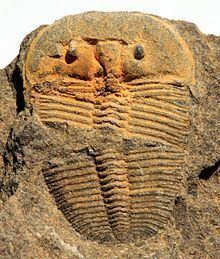Family Aulacopleuridae Rank Genus | Class Trilobita | |
 | ||
Similar Proetida, Acastoides, Cheirurus, Diacalymene, Placoparia | ||
Aulacopleura is a genus of proetid trilobite that lived from the Middle Ordovician to the Middle Devonian. The cephalon is semicircular or semielliptical, with border and preglabellar field. The glabella is short, with or without defined eye ridges connecting it with eyes of variable size. Spines at the rear outer corners of the cephalon (or genal spines) are present, typically reaching back to the 2nd to 4th thorax segment. The 'palate' (or hypostome) is not connected to the dorsal shield of the cephalon (or natant). The cephalon is pitted, or has small tubercles. The thorax has up to 22 segments. The pleural ends are usually rounded. The pygidium is small (micropygous), with an even margin.
Contents
Taxonomy
Barrande described Arethusa konincki in 1846. However, Arethusa was occupied since it was used by De Montfort in 1808 for a foram protist. Barrande tried to correct this by proposing Arethusina as a replacement, but by that time that Hawle and Corda had already suggested Aulacopleura in 1847, which is thus the senior available name.
